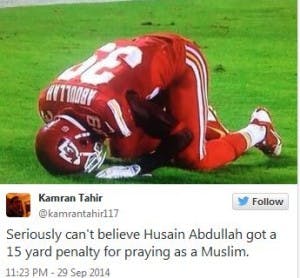By Eric B. Meyer
After scoring a touchdown against the New England Patriots on Monday night, Kansas City Chiefs safety Husain Abdullah dropped to his knees and prayed.
As Kevin Draper at Deadspin.com reports, a tweet from Abdullah’s brother further confirmed that the player’s post-TD celebration was a Muslim prayer.
Except the referees responded with a 15-yard penalty on the Chiefs for excessive celebration, for which the NFL later accepted blame.
Oops.
Lessons for employers from the NFL’s mistake
What can employers learn from the NFL’s mistake? Here are a few lessons on accommodating prayer in the workplace.
As discussed recently in a post, Title VII requires employers to reasonably accommodate the religious observances of its employees unless it would create an undue hardship. A religious accommodation undue hardship is something more than a de minimis cost.
So, how can employers make sure that they get this right?
- Don’t waste much psychic energy questioning an employee’s religion. As long as an employee’s beliefs are sincerely-held, then the employee is covered under Title VII.
- Treat all religions equally. Tebow versus Abdullah. Christianity versus Muslim. One received no penalty; the other did. If you are going to allow prayer (or some other accommodation) in the workplace for one religion, allow it for all.
- Ban prayer altogether? Think again. Let’s suppose that a group of Muslim employees ask you for 15 minutes each day to pray to Mecca. If allowing 15 minutes is going to create a noticeable cost to you, then you don’t have to allow it. EXCEPT, if you allow other non-Muslim employees the time to pray, then, yes you do. Or, if you allow other non-religious employees 15-minute breaks to smoke or whatever, then, yes you do. There may be other instances in which a similar accommodation is appropriate too.
Don’t let the controversy surrounding the NFL’s blown call on Monday night — if only that were Roger Goodell’s biggest headache over the last month — create problems in your workplace, too.
This was originally published on Eric B. Meyer’s blog, The Employer Handbook.
